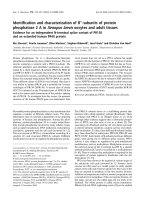Bài đọc 6.2. A sociable workplace is happier and more productive. Here's why (Chỉ có bản tiếng Anh)
Bạn đang xem bản rút gọn của tài liệu. Xem và tải ngay bản đầy đủ của tài liệu tại đây (167.88 KB, 2 trang )
<span class='text_page_counter'>(1)</span><div class='page_container' data-page=1>
Creating a Great Organizational Culture in the Public Sector
Government agencies in North America can learn an important lesson from the private sector. Workers who are happy and
motivated will achieve greater results and increased citizen satisfaction than workers who are unhappy and discontented.
<b>What is organizational culture?</b>
“An organization’s culture is a social reality that signals to employees what they should do, feel and think. It’s a set of behavioral,
emotional, and psychological frameworks that members adopt and perpetuate, often unconsciously. It is ‘the way we do things
around here,’” stated David Osborne and Peter Plastrik in their 2000 book, The Reinventor’s Fieldbook: Tools for Transforming Your Government. Edgar
Schein, in his 2010 book Organizational Culture and Leadership, Fourth Edition, writes, “Culture is to a group what personality or character is to an
individual” and “[t]he essence of a culture is the paradigm by which people operate.”
What does a great organizational culture look like? In many places, it appears as engaged employees who are invested in their jobs and committed to their
employers. They are significantly more productive, and they drive higher citizen satisfaction ratings.
<b>How can public sector agencies create great organizational cultures?</b>
Private companies such as Google and Facebook famously invest financial resources into creating a positive and productive employee culture. How can
public sector agencies have the same type of success, given dwindling resources and the accountability of spending taxpayers’ dollars? The good news is
that it doesn’t have to be exorbitantly expensive to create a great organizational culture.
Depending on how toxic the existing culture is at the start, it may take a fundamental shift in philosophy and it is likely to be neither fast nor easy – but it
CAN be done. Public organizations can help employees enjoy work and reach their true potential. It is possible for employees to make a difference and
have fun doing it.
Progressive public agencies recognize employees’ strengths and provide opportunities that help them build on those strengths. Here are some ways that
agencies are cultivating groups of thriving employees:
<i><b>Matrix Teams/Matrix Management – a concept first introduced to the public sector by NASA in 1965. Matrix teams include people from different</b></i>
departments, functions or organizations who come together to solve a common problem or achieve a goal through collaboration. A matrix team is a tool
that facilitates the horizontal flow of skills and information. Employees are selected from different functional disciplines for assignment to a team without
removing the employees from their respective organizational positions. Matrix teams allow an agency to utilize the talents of all staff, regardless of the
payroll position they occupy. This process develops depth in employees and allows for professional growth opportunities.
<i><b>Participatory Leadership – this can be accomplished through mechanisms such as an employee advisory team that allows employees to provide input</b></i>
into policies and programs to design a first rate work environment. This team can empower and develop employees to their fullest potential, create
assignments based on employee strengths, and allow employees to fully explore their interests as innovative ideas are brought forward.
<i><b>Wellness and Life Balance Programs – many public agencies have learned the importance and value of offering programs such as flexible work</b></i>
schedules, onsite daycare, onsite dry cleaning pickup and delivery and onsite exercise classes. Employees often happily pay the cost of these amenities.
The convenience of having many services onsite and the time saved running errands after or before work means more time available for family and/or
pursuits of personal interest.
<i><b>Fun – this doesn’t have to be expensive. Organizations such as the </b></i>City of Rancho Cordova, California (the first local government agency to earn the
<i>distinction as one of Fortune’s Great Places to Work), and the </i>City of Edmonton, Alberta, Canada both use fun in the workplace to inspire and motivate
employees. From small celebrations to friendly competitions to themed dress-up days, employees are happier if they are having fun and like where they
work. Ask around – it’s possible to find a ping-pong table or a foosball game that someone will donate for employees to play during breaks.
<i><b>Communication – open and honest communication alleviates many concerns and helps employees feel happier and more secure at work.</b></i>
Communication either in person, in an email or with a handwritten note helps workers feel better, more connected and more engaged at work.
<i><b>Pursuit of Passions – encourage employees to preserve time to focus without interruption on their most important priorities. Then, give them a</b></i>
designated amount of time to pursue projects that they’re passionate about and which have the potential to add value to the organization.
<i><b>Be a Learning Organization – “A ‘learning’ organization is one that does not merely react to changes that happen to it, but is a proactive agent that can</b></i>
initiate change in its own environment,” states Ted Gaebler in the 1999 book Positive Outcomes: Raising the Bar on Government Reinvention, “[t]he
organization needs to see itself as part of its environment and not only an objective observer of it.” Edgar Schein, in Organizational Culture and
<i>Leadership, Fourth Edition, 2010, adds “It will be more important to be committed to the learning process than to any particular solution to a problem.” </i>
Learning organizations are more resilient and encourage new growth opportunities for workers who are eager and engaged.
<i><b>Preparing the Next Generation (PNG) — Frank Benest, with the International City/County Management Association’s PNG program, lists in his</b></i>
2003 report on Preparing the Next Generation many challenges to ensuring a continuity of successfully prepared future leaders in the public sector.
Among them are anti-government biases, different general values and a lack of succession planning. Benest recommends strategies that include
recognizing and emphasizing talent development, creating specific opportunities for young talent to develop both hard and soft skills, challenging aspiring
managers to stretch themselves and take on new roles, and moving up-and-comers around in the organization so that they gain line as well as staff
experience and learn the different disciplines of local government to appreciate diverse perspectives. Growth opportunities are very important. Employees
are unlikely to be happy in a job that offers no room for growth and advancement.
</div>
<span class='text_page_counter'>(2)</span><div class='page_container' data-page=2>
About
The American Society for Public Administration is the largest and most prominent professional association for public
administration. It is dedicated to advancing the art, science, teaching and practice of public and non-profit administration.
Mail | More Posts(1737)
<b>What should an agency do when it finds the recipe for a great organizational culture?</b>
Once you find a formula that works, stick with it. “[I]f you get the recipe right, based on practical insight and empirical validation,” according to Jim
Collins and Morten T. Hansen in their 2011 book Great by Choice, “it should serve you well for a very long time. Continually question and challenge your
recipe, but change it rarely.”
<b>Results</b>
Creating a great organizational culture leads to results. In The Culture Cycle, 2011, James Heskett demonstrates that an effective culture can result in a
20-30 percent positive differential in performance. Heskett describes the advantages of a great culture with the “Four Rs”: Referrals, Retention of employees,
Returns to labor, and Relationships with customers. For public agencies, this means greater productivity with fewer resources in less time and with an
increase in citizen satisfaction ratings.
____________________________________________________________________________
<i><b>Author: ASPA member Troy Holt, MPA, has 24 years of public agency experience in departments ranging from police, public works, transportation,</b></i>
<i>administrative services and the city manager’s office. He is currently the Communications and Legislative Affairs Manager for the City of Rancho</i>
<i>Cordova, CA. He can be reached via email at </i>
Image courtesy of />
<b> (18 votes, average: 4.56 out of 5)</b>
</div>
<!--links-->
Ngữ pháp cơ bản T.Anh 6
- 2
- 493
- 3








